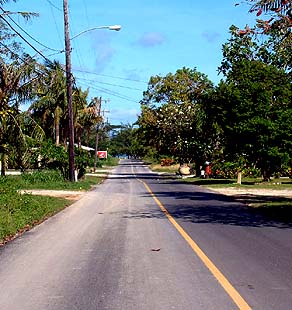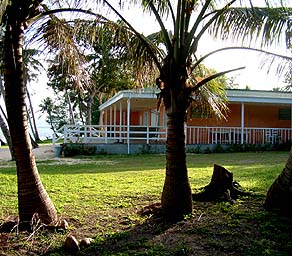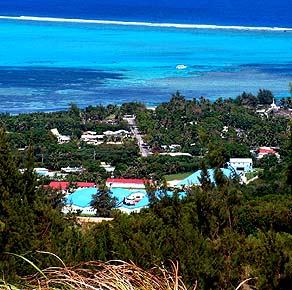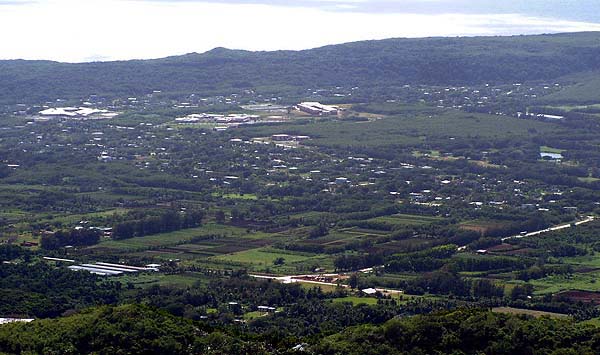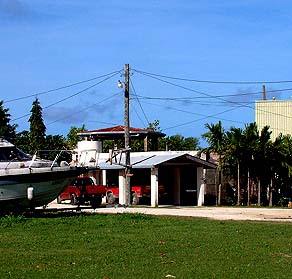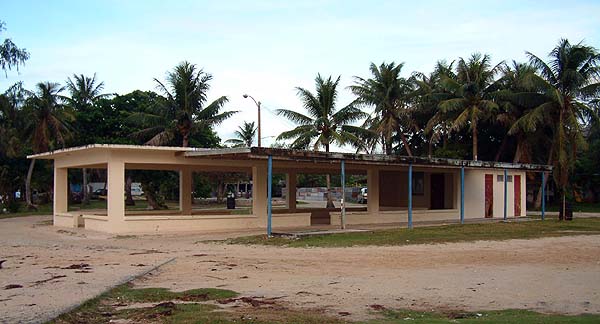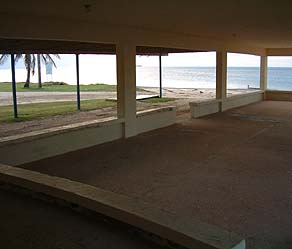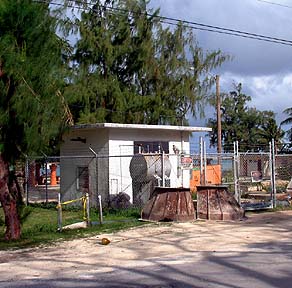 |
 |
 |
|||||
|
|
|
|
|
|
|
|
|
|
|
|||||||
|
|
|
|
|
|
“The village has changed a lot,” Pete says, “I remember back during those times when I was about seven or eight years old, we had a wooden house. We didn’t have a concrete house at that time. It was all wooden houses, and the houses were located beside the beach. The house lot there was a very small lot, not like at this time. Now it’s more spread out. But where the church is, straight up from the church and all the way down there to the beach, that’s where the houses used to be."
|
||
|
|
||
“During those times, we experienced all these typhoons. Whenever there was a typhoon, the water from the ocean would come in all the way right up in front of the church. That’s why the people moved away from the beach. “And during those times there was barbed wire. We were restricted from the area on the other side of the church, because it was used by military. So where the church is, there was a house here, and there was a barbed wire fence here, all the way from the main road to the beach. That was off limits at that time. "When that area opened up, people moved because of the typhoon threat. That’s how people became spread out. But during those earlier days, all people were farming and fishing.”
|
|
|
“Today, if you are a beach owner, you’re a rich man,” Ben says, “with the development of tourism and other industries. They prefer million-dollar beach sites. Even if they know about typhoon activities, they still prefer the beach. But I don’t see tourism development creeping in on Tanapag in the immediate future. Not even in the long future. "This is a unique village. They tried to build a hotel here, but we all gathered up and said no way. We’re not going to be subjected to lifeguards or beachcombers in our own beach, and the Coastal Resources Management office rightfully denied the permit to build a hotel right in the heart of Tanapag."
|
“We have mom-and-pop stores, maybe three. None of them are owned by local people. And we have a local person who built an apartment-type building and washerette, where you can wash your clothes. Otherwise, there’s not a whole lot, in terms of commercialization in the village. “In the broader village, in the areas surrounding Tanapag village we have garment factories galore. We have maybe ten garment factories just outside of the village. Some are huge, some are half huge. There’s nothing small. No sweat shops, so to speak. Maybe many, many years ago there were, but we’re not privy to that kind of information. "You’re actually not allowed to go into the factories if you’re not a worker, and so we’ve not seen people get locked up in their barracks. But these ‘barracks’ are really type of apartment. They’re not run-down barracks. They’re well taken care of."
|
|
|
|
|
Homestead lots in Kagman.
|
"The homesteading program started to displace a lot of our Tanapag people. They got homesteads in Kobler, homesteads in Dandan, homesteads in Kagman, and so they moved out of here. Not necessarily the whole clan, but some of the clan members would move out. "They do come back here and participate in a lot of cultural activities. First, probably the installations of our chiefs. That’s a cultural activity. But we have not had that recently because the chief is still alive today. If the chief passes away, that title would be passed to some other clan members, and there would be an installation of chief. That’s when our big Carolinian happenings occur again."
|
||
|
|
||
"The homesteads are recent. In the olden days, when you cleared a piece of property, later on you could claim it, and they'd normally assign that property to you in writing. Now you apply for a homestead lot, and they’ll look at your belongings, whether you have a piece of land from your mother or from your father, and whether you have a place where you can build something. "A family with maybe two or three kids, or even one child, that’s a qualifying position. I got mine in a lottery form. They’ll announce that they have ten homesteads open, but there twenty of us might go down there, so we go down there and pick a piece of paper. If there's a number on it, then you have a lot, and that’s how I got my property, for $50."
|
|
|
"There’s homestead land all over Saipan, Rota and Tinian. The Division of Marianas Public Land Corporation is charged by the Constitution and by State Laws to research properties that can be developed into a village. They do that to relieve congested areas. Tanapag village was congested back in the 1970s,so they gave people land to release that pressure in the village. "That’s the inception of homesteading on the islands of Saipan, Tinian and Rota. They also opened up homesteading land in Kobler, Dandan, Kagman, Tanapag, As Matuis, and up in San Roque. There are quite a few new homesteads in those areas."
|
"Homesteading has diminished the socialization of the immediate family because now some of them are in Kagman. Some of them are in Kobler. Driving to these places is not a big deal, but it takes too much time to walk. "Now you have to drive, or the children have to drive, and in these days not everybody can own a vehicle. It’s quite expensive in the very beginning, and that is the disadvantage of being separated. But otherwise I think that it’s more advantageous in that it decreases the social pressure in the village."
|
|
|
|
|
“When they started opening the homesteads,” Estella says, “people would go and apply for a homestead, and those people that applied from other parts of the village, when they pulled their lot, if Tanapag was the place where they were given, they opened a homestead here. So we got people from all over Saipan. And even our people, some of them moved to other places because when that land was opened, they gave them homesteads elsewhere. It almost seems like most of the Tanapag people live in Kagman, in Koblerville, and in As Matuis. We used to stay together. Now it’s harder to see all your family.”
|
||
|
|
||
The beach social hall at Tanapag.
|
"This structure here is really not new," Ben says, pointing to the beachside social hall. "It’s probably from back in the ‘70s. We had a Mayor, and people would elect somebody in the village as their Commissioner. And Commissioners would probably find some budget money. In those, it was very difficult to get large sums of money to build any kind of community project, but apparently, this is one of the first. Instead of building an utt that belongs to clan, they built a social hall open for the general public."
|
||
|
|
||
“That’s what politics brought into the village. But I think it’s a good thing, because everybody can use it. If they were to put up the utt, very likely you wouldn’t be able to use the place if you weren't a member of the clan. It’s kind of protected. “This one here is controlled by the Mayor’s office, but you can have it on Sunday for the asking. It gets used every Sunday, and for every fiesta of our church. A lot of picnics have happened here. But as time has passed, the infrastructure of the village has developed, and now we have a new problem.”
|
|
|
"Behind the hall is what they call a Lift Station. This is a pump. See, the sewer line flows down here, and there has been an overflow problem. So there’s a conflict between the sewer line and the social hall. Here we put a social hall, with the idea to bring many people here for relaxation, particularly during weekends, or birthdays, or weddings. "But now we’re worried that the overflow of the sewage just defeats that purpose. We don’t want to come play around, frolic on this area, where it’s highly contaminated with bacteria." After this social hall was damaged by a typhoon, FEMA (Federal Emergency Management Administration) gave money to Tanapag to build a new one. Click here to read about the Tanapag Youth Center.
|
|
|
|
“The major problem that the village has is environmental contamination,” Juan says. “To deal with this issue, we formed the Tanapag Action Group with Ben Sablan, myself, Sylvestre Iguel, Henry Iguel, Vic Igitol, Alan Palacios, and Pete Teigita. We’re all members and we’re all trying our very best to request and demand that the Federal Government come and clean it up. As you can see now, the PCB problem is being addressed. And they’re building sample wells all over the village to test the ground water for chemical contamination.” “Over 20,000 tons of soil have been treated,” Ben points out. “They separate the PCB from the soil. A lot of soil has been removed from the village. It’s the biggest issue facing the villages and community of this village today. And it’ll be an ongoing issue for many more years to come.”
|
||
|
|
||
The social impact of changes taking place in the village, and the rise of the Tanapag Action Group, are reflected by the changing constitution of the community itself.
|
||
|
|
||
|
|
|
|
|
|

|
| Tanapag Home | Map Library | Site Map | Pacific Worlds Home |
|
|
|
|

|
|
|
|||
| Copyright 2003 Pacific Worlds & Associates • Usage Policy • Webmaster |
|||

